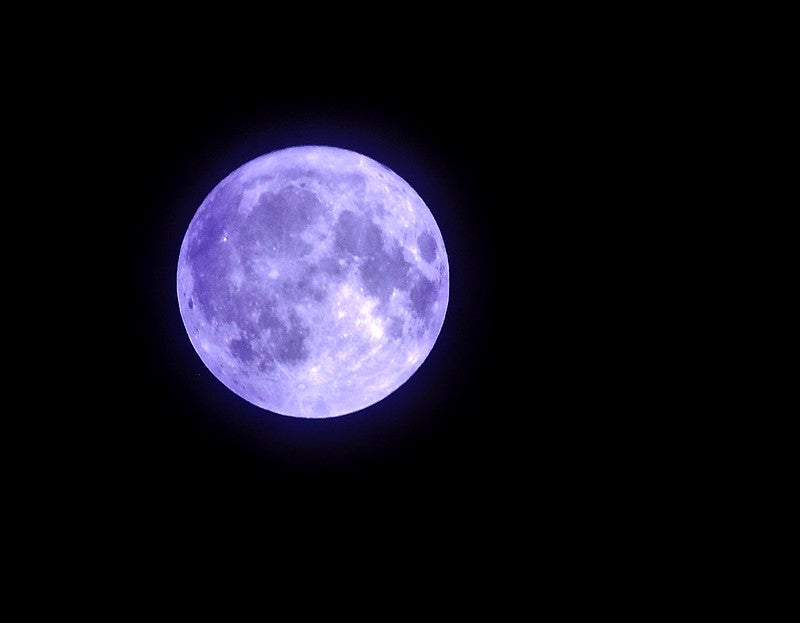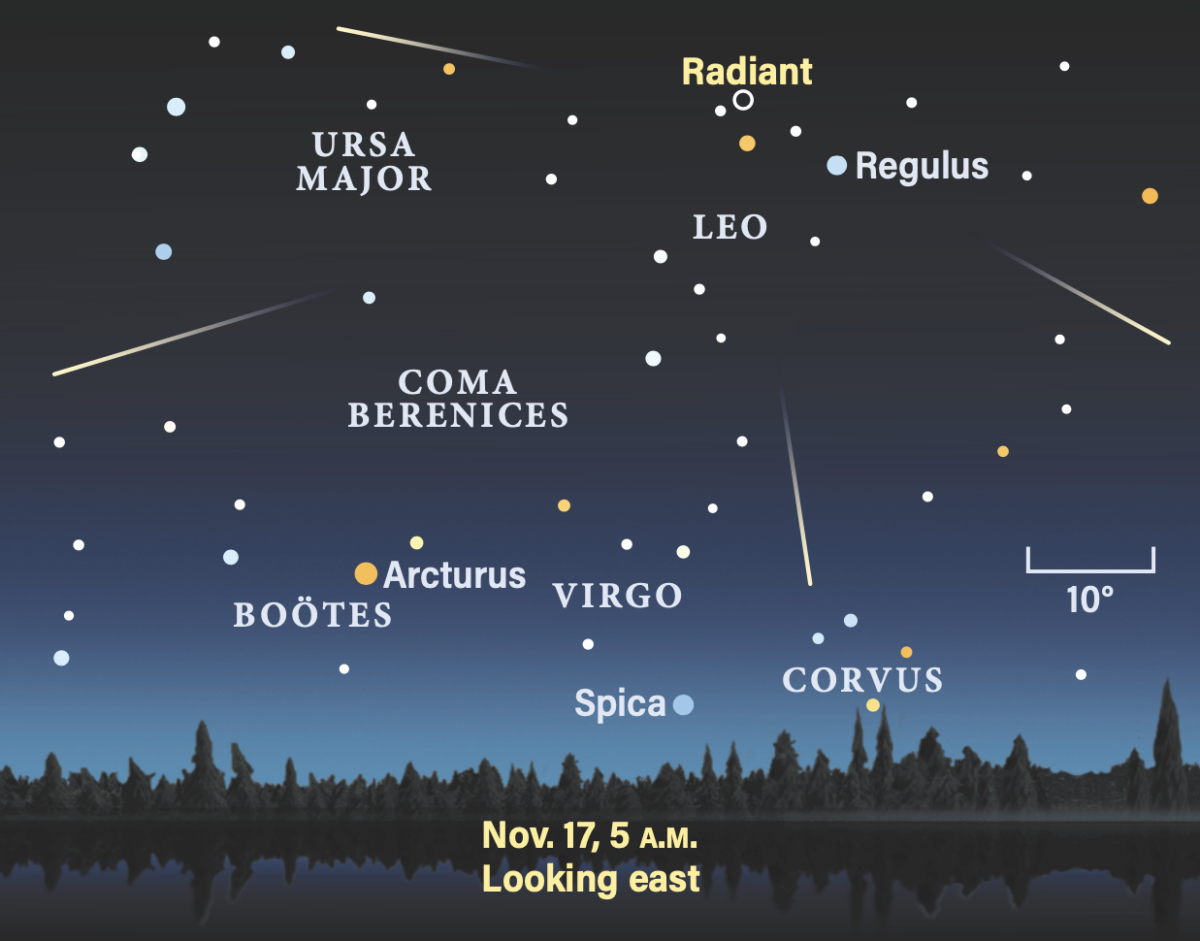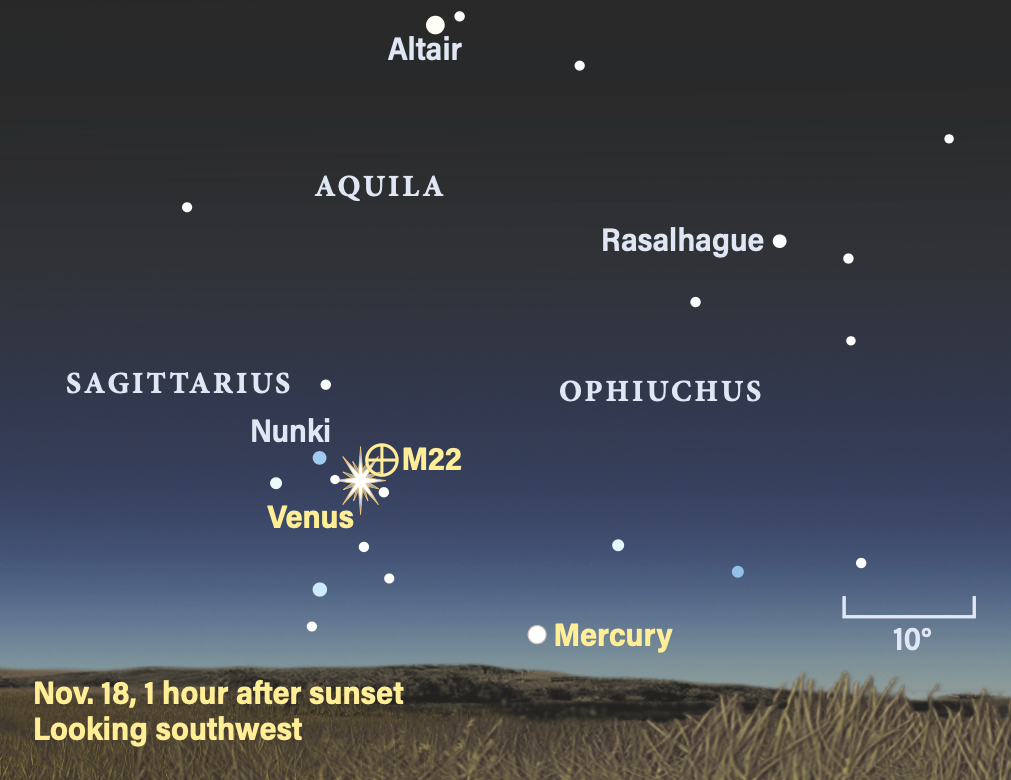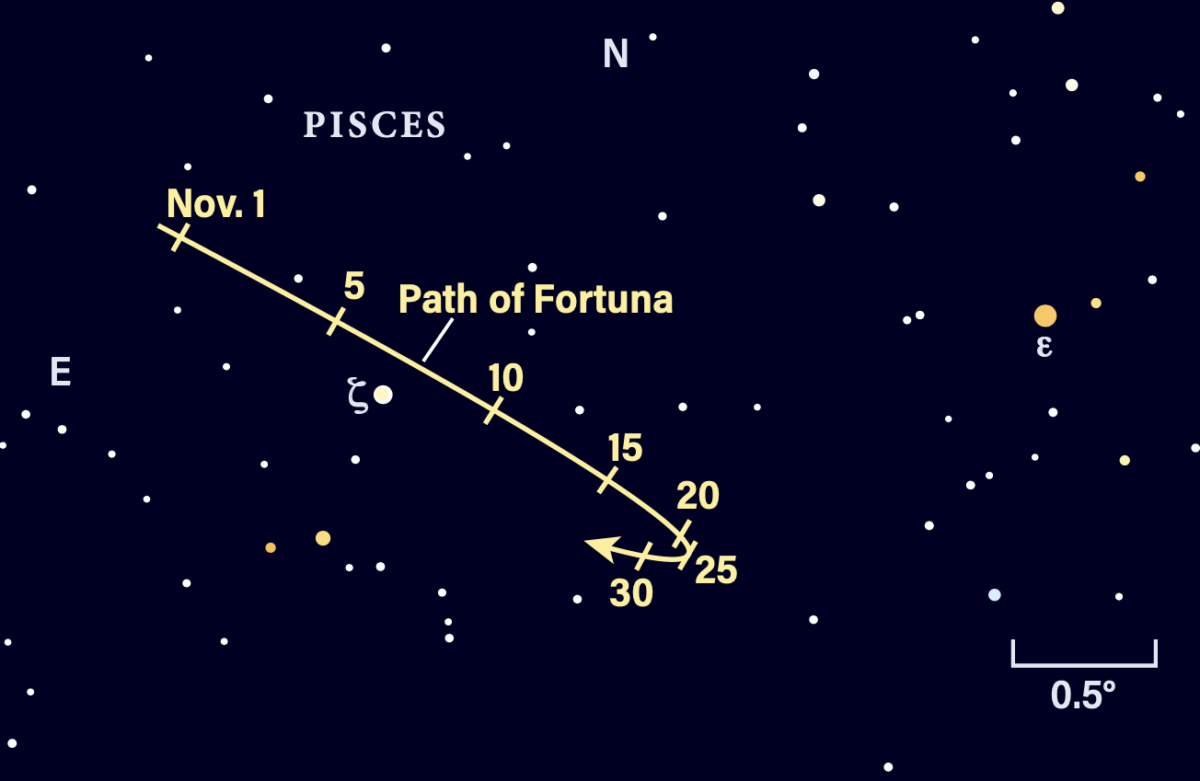
Friday, November 15
We’re starting out the week strong with the Moon on center stage. November’s Full Moon, also called the Beaver Moon, occurs at 4:29 P.M. EST. But there’s more to this Full Moon — it’s a Super Moon, which occurs when the Moon reaches Full near its closest point to Earth, called perigee. It reached this point yesterday, and this afternoon is still just 224,853 miles (361,866 kilometers) from Earth. This is the fourth and final Super Moon of 2024; the next Super Moon won’t occur for nearly a year, in October 2025.
You can catch the bright Full Moon rising in the east around sunset, as this phase always pits our satellite opposite the Sun in the sky. At 8 P.M. EST, the Moon passes 4° due north of Uranus, which itself sits 6.5° southwest of the Pleiades (M45). At magnitude 5.6, Uranus will not be visible without binoculars or a telescope, especially with the bright Moon nearby.
And keep an eye on the Pleiades, which lie left of the Moon the sky as they are rising — as the hours pass, the Moon draws closer and closer to this bright open cluster until, starting late on the 15th in the western U.S. and early on the 16th farther east, our satellite begins to block several stars in the cluster from view in an occultation.
The timing of the event — and even which stars are covered — is heavily location dependent. From the central U.S., Electra is the first bright star to disappear, shortly before 1 A.M. CST on the 16th, followed by Merope, Alcyone, Atlas, and Pleione.
The International Occultation Timing Association’s website offers occultation timing from several locations. You can find the list of 40 major cities in North America here.
Sunrise: 6:46 A.M.
Sunset: 4:43 P.M.
Moonrise: 4:21 P.M.
Moonset: 6:32 A.M.
Moon Phase: Full
*Times for sunrise, sunset, moonrise, and moonset are given in local time from 40° N 90° W. The Moon’s illumination is given at 12 P.M. local time from the same location.
Saturday, November 16
Saturn ends its retrograde motion, standing stationary against the background stars of Aquarius at 1 A.M. EST. After today, it will begin moving prograde, or eastward, through the constellation.
Mercury reaches greatest eastern elongation from the Sun, standing 23° from our star at 3 A.M. EST. You can catch the innermost planet in the early-evening sky, now 5° above the southwestern horizon half an hour after sunset and glowing at magnitude –0.2. Through a telescope, its disk now appears 7” across and is 62 percent lit — if you managed to catch a glimpse last week, you’ll note the change in illumination.
Located to Mercury’s far upper left is Venus, blazing at magnitude –4.1. It lingers for about 2½ hours after sunset, and tonight sits near the tip of the Teapot asterism’s lid, 3rd-magnitude Kaus Borealis (Lambda [λ] Sagittarii). The two are just 0.5° apart, visible together in the field of view of a telescope. Through that scope, Venus’ width spans 16” and it appears 72 percent lit — also a change from last week, but far less of one than Mercury.
But the planet of the night is the ice giant Uranus, which reaches opposition at 10 P.M. EST in Taurus the Bull. Standing highest in the southern sky around local midnight, you’ll find Uranus 6.7° southwest of Alcyone (Eta [η] Tauri) in the Pleiades. At magnitude 5.6, the distant world is not readily visible to the naked eye, especially with the still-nearly Full Moon lingering nearby. Use binoculars or a telescope to slide your gaze due south of the Pleiades — there, you’ll find a pair of 6th-magnitude stars, 13 and 14 Tau, in an east-west line. Uranus, nearly the same brightness as 13 Tau (the westernmost star), sits 3° southwest of this star, near the border of Taurus and Aries. Through your optics, the planet will appear as a “flat” star with a grayish color. Its disk is just 4” across.
Sunrise: 6:47 A.M.
Sunset: 4:42 P.M.
Moonrise: 5:05 P.M.
Moonset: 7:53 A.M.
Moon Phase: Waning gibbous (99%)

Sunday, November 17
The Leonid meteor shower peaks today, unfortunately with a bright gibbous Moon still in the sky. Our satellite is still located in Taurus, passing 6° north of Jupiter at 10 A.M. EST.
Around 5 A.M. local time, the Moon sits to Jupiter’s upper right as Taurus slowly sets in the west; despite the bright moonlight, Jupiter is still readily visible at magnitude –2.8. The gas giant is located between the two horns of the Bull, directly above the constellation’s brightest star, the magnitude 0.9 red giant Aldebaran.
Over in the eastern sky, Leo the Lion is climbing high, his head some 65° above the horizon. The Leonids’ radiant is in the “neck” of the Lion, just southwest of Zeta (ζ) Leonis. With a maximum expected rate of 10 meteors per hour, the Leonids won’t produce a ton of meteors, and those that do streak through the sky will be difficult to spot with the bright Moon up. Still, try casting your gaze to the north — here is where you might see a few bright shooting stars with longer trains if you’re lucky.
The Leonids, generated by debris left from Comet 55P/Tempel-Tuttle, are technically active through the end of November. So, consider stepping outside in the hour or two before dawn as the Moon starts to wane to see whether you have better luck. Unfortunately, the Last Quarter Moon lingers through the early-morning hours and sets after sunrise, which will continue to make observing the tail end of this shower a bit challenging.
Sunrise: 6:48 A.M.
Sunset: 4:42 P.M.
Moonrise: 5:59 P.M.
Moonset: 9:09 A.M.
Moon Phase: Waning gibbous (95%)

Monday, November 18
Magnitude –4.1 Venus moves to stand 1.6° north of the globular cluster M22 in Sagittarius this evening. At magnitude 5.1, M22 is considered the Archer’s finest globular — look for it with binoculars or a telescope starting an hour after sunset, located to Venus’ upper right as Sagittarius is setting in the southwest.
Venus’ disk still appears 16” wide and 72 percent lit. By contrast, M22 spans 32’ — roughly the width of the Full Moon — and was one of the first globular clusters to be discovered. Globular clusters are ancient balls of aging stars distributed in a roughly spherical halo around our Milky Way. M22 contains some 70,000 stars, many of which are visible even in small telescopes — apertures less than 4 inches will begin to show individual suns scattered around the bright, densely packed core.
As a bonus, M22 is one of just four globulars that also house a planetary nebula. GJJC 1 is located 1’ south of the cluster’s central regions — but requires a 20-inch scope to spot, and even then will be difficult at this time of year, with the region setting shortly after the Sun. Instead, make a note to try for it next summer in July and August, when Sagittarius is highest in the sky for Northern Hemisphere observers.
Sunrise: 6:49 A.M.
Sunset: 4:41 P.M.
Moonrise: 7:02 P.M.
Moonset: 10:14 A.M.
Moon Phase: Waning gibbous (89%)
Tuesday, November 19
Saturn’s largest and brightest moon, Titan, is located relatively close to the ringed planet tonight. You’ll find Saturn in Aquarius, high in the south around local midnight and glowing at magnitude 0.8 — brighter than any of the stars around it. Zoom in with a telescope, and you’ll immediately enjoy the sight of the planet’s stunning rings, stretching some 40” from end to end and nearly 4” wide at their shorter axis.
Titan, shining at 8th magnitude, stands some 45” southeast of the planet’s center early in the evening and will slowly move closer to the planet overnight. By tomorrow evening, the moon will have passed south of Saturn from our point of view and will then sit roughly the same distance from the planet’s center as today, but now situated to the southwest. Titan takes about 16 days to orbit Saturn, so appears closest to the ringed world once a week or so.
Early this evening, observers with larger scopes may also spot 10th-magnitude Dione just northwest of the planet; around 9 P.M. EST, the small moon is occulted as it passes behind the planet’s disk. It won’t reappear until shortly before 1 A.M. EST (on the 20th for those in the Eastern time zone, and approaching midnight in the Central time zone), having traveled not only behind Saturn, but also through its dark shadow to the northeast. When Dione winks back into view, it will be some 5” from Saturn’s northeastern limb.
Sunrise: 6:50 A.M.
Sunset: 4:40 P.M.
Moonrise: 8:10 P.M.
Moonset: 11:07 A.M.
Moon Phase: Waning gibbous (81%)
Wednesday, November 20
The Moon passes 2° north of Mars at 4 P.M. EST; the two are visible in the early-morning sky, more than 60° high in the southwestern sky two hours before sunrise. At this time, the Moon is still fairly far from Mars, hanging to the Red Planet’s lower right. Mars is near the central region of Cancer the Crab, glowing at magnitude –0.3. It’s some 3° northwest of the Beehive open cluster (M44), which should be readily visible in binoculars or a telescope. The cluster is often visible to the naked eye, but the bright Moon nearby may wash it out this morning.
Today, Mercury reaches 50 percent lit — you can observe the half-lit face of the tiny planet with a telescope shortly after sunset. Now magnitude –0.1, Mercury is still 5° high half an hour after sunset. As long as your southwestern horizon is clear, you should have a great chance at finding it.
Back at Saturn, the two-faced moon Iapetus reaches eastern elongation, standing 8.5’ east of the planet. Because Iapetus’ two hemispheres have significantly different compositions and reflect light differently, at eastern elongation the moon is faintest, around 12th magnitude, and requires larger telescopes to spot. When it reaches western elongation on New Year’s Eve, it will be at its brightest — 10th magnitude, as bright as Dione, Rhea, and Tethys.
Sunrise: 6:51 A.M.
Sunset: 4:40 P.M.
Moonrise: 9:20 P.M.
Moonset: 11:49 A.M.
Moon Phase: Waning gibbous (72%)

Thursday, November 21
With the Moon now below the horizon for much of the evening, we can hunt down a 140-mile-wide (225 km) main-belt world: 19 Fortuna. It’s 10th magnitude, easy to pick out among the relatively sparse background stars of Pisces with even a relatively small scope at low power.
Start your search this evening at 5th-magnitude Zeta Piscium, a stunning double star that actually consists of many more stars, though only two are distinguishable by eye. The two visible stars appear about 25” apart, shining at 5th and 6th magnitude.
From Zeta Psc, simply slide about 1.3° west-southwest to land on Fortuna. With a relatively dark surface, Fortuna doesn’t reflect much light, but it’s also not far from the Sun, now only about 20 percent farther from our star than Earth. The lack of bright background stars further helps observers to identify it in the eyepiece.
Fortuna is moving relatively quickly against the background as well — come back night after night to check and see which bright spot in this region has moved. That’s the asteroid.
Sunrise: 6:53 A.M.
Sunset: 4:39 P.M.
Moonrise: 10:27 P.M.
Moonset: 12:21 P.M.
Moon Phase: Waning gibbous (63%)
Friday, November 22
Last Quarter Moon occurs at 8:28 P.M. EST. Once again, the evening sky is dark, offering a nice long window for deep-sky observing.
A few hours after sunset, Auriga is well above the northeastern horizon. Its brightest star, magnitude 0.1 Capella, is easy to spot in the sky. To Capella’s lower right is Auriga’s beta star, magnitude 1.9 Menkalinan. It is near this star that we’ll find our target tonight: the planetary nebula IC 2149.
Shining around 11th magnitude, IC 2149 sits just 1.3° northeast of Menkalinan. Its compact size of just 8.5” means that its light is fairly concentrated, making it easier to pick up with a telescope. Many observers are able to see its light blue color, and Astronomy columnist Stephen James O’Meara describes its shape as “a knotty ring seen almost edge-on.” You’ll need higher power to see that structure, but lower power will better show its color, so try switching between the two for the full view.
Sunrise: 6:54 A.M.
Sunset: 4:38 P.M.
Moonrise: 11:31 P.M.
Moonset: 12:47 P.M.
Moon Phase: Waning gibbous (53%)

Sky This Week is brought to you in part by Celestron.

